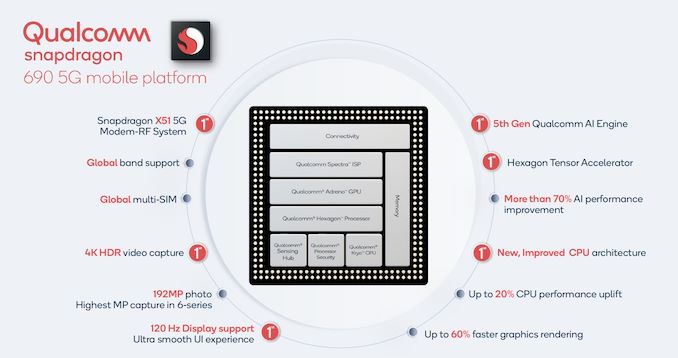Qualcomm Announces Snapdragon 690: 5G & A77 In The Mid-Range
by Andrei Frumusanu on June 16, 2020 10:00 PM EST- Posted in
- Mobile
- Qualcomm
- Smartphones
- SoCs
- Snapdragon 690

Today Qualcomm is extending its 5G SoC portfolio down to the Snapdragon 600-series, introducing the new Snapdragon 690 platform and chip. The new design is a more significant upgrade to the 600-series, not only upgrading the cellular capabilities, but also upgrading some of the cornerstone IPs to the newest generation available.
| Qualcomm Snapdragon 600-Range SoCs | |||||||
| SoC | Snapdragon 660 | Snapdragon 662 | Snapdragon 665 | Snapdragon 670 | Snapdragon 675 | Snapdragon 690 | |
| CPU | 4x Kryo 260 (CA73) @ 2.2GHz 4x Kryo 260 (CA53) @ 1.8GHz |
4x Kryo 260 (CA73) @ 2.0GHz 4x Kryo 260 (CA53) @ 1.8GHz |
4x Kryo 260 (CA73) @ 2.0GHz 4x Kryo 260 (CA53) @ 1.8GHz |
2x Kryo 360 (CA75) @ 2.0GHz 6x Kryo 360 (CA55) @ 1.7GHz |
2x Kryo 460 (CA76) @ 2.0GHz 6x Kryo 460 (CA55) @ 1.7GHz |
2x Kryo 560 (CA77) @ 2.0GHz 6x Kryo 560 (CA55) @ 1.7GHz |
|
| GPU | Adreno 512 | Adreno 610 | Adreno 615 | Adreno 612 | Adreno 619L | ||
| DSP | Hexagon 680 | Hexagon 683 | Hexagon 686 | Hexagon 686 | Hexagon 685 | Hexagon 692 |
|
| ISP/ Camera |
Spectra 160 24MP |
Spectra 340T 25MP single / 16MP dual |
Spectra 165 25MP single / 16MP dual |
Spectra 250 25MP single / 16MP dual |
Spectra 250 25MP single / 16MP dual |
Spectra 355L 48MP single / 32+16MP dual |
|
| Memory | 2x 16-bit @ 1866MHz LPDDR4 14.9GB/s |
2x 16-bit @ 1866MHz LPDDR4X 14.9GB/s 1MB system cache |
|||||
| Integrated Modem | Snapdragon X12 LTE | Snapdragon X11 LTE (Cat 12/13) DL = 390Mbps 2x20MHz CA, 256-QAM UL = 150Mbps 2x20MHz CA, 64-QAM |
Snapdragon X12 LTE (Category 12/13) DL = 600Mbps 3x20MHz CA, 256-QAM UL = 150Mbps 2x20MHz CA, 64-QAM |
Snapdragon X51 ( LTE ) DL = 1200 Mbps UL = 210 Mbps ( 5G NR Sub-6 ) DL = 2500 Mbps UL = 1200 Mbps |
|||
| Encode/ Decode |
2160p30, 1080p120 H.264 & H.265 |
1080p60 H.264 & H.265 |
2160p30, 1080p120 H.264 & H.265 |
||||
| Mfc. Process | 14nm LPP | 11nm LPP | 11nm LPP | 10nm LPP | 11nm LPP | 8nm LPP | |
Although the new Snapdragon 690 maintains its CPU configurations in terms of big and little cores in a 2+6 setup, Qualcomm has managed to include the newest Cortex-A77 IP for the big CPU cores, resulting in a 20% performance uplift thanks to the microarchitectural improvements. The clock speeds remain the same as found in other recent 600-series designs, meaning 2GHz on the big cores and 1.7GHz for the A55 cores.
On the GPU side, we see the shift to a new Adreno 619L design sees a much bigger shift with an up to 60% increase in performance compared to the previous generation Snapdragon 675.
Memory-wise, it’s still a LPDDR4X SoC with dual 16-bit channel support, which is plenty for the bandwidth requirements at this performance segment.
Qualcomm is also trickling down some of the newer higher end multimedia features to the 600-series, such as the newer generation Spectra iSP which is able to support up to 192MP still pictures or up to 48MP sensors with multi-frame noise reduction, or a dual-camera setup in tandem of 32+16MP sensors. The chip has a 10-bit capture and display pipeline, allowing it 4K HDR capture and display – although we didn’t see mention of 4K60 recording.
The key feature of the Snapdragon 690 is its shift towards a 5G modem platform. The integrated X51 modem now adds support for 5G sub-6GHz with global band support. The speeds here scale up to 2500Mbps downstream and 1200Mbps upstream on sub-6 networks, utilising up to 100MHz of spectrum bandwidth. The chip seemingly makes without mmWave connectivity, and this makes a lot of sense given the price range that the 600-series is meant to be used in, as well as the general lack of mmWave adoption in most markets.
“This new platform is designed to make 5G user experiences even more broadly available around the world. Snapdragon 690 also supports remarkable on-device AI and vibrant entertainment experiences. HMD Global, LG Electronics, Motorola, SHARP, TCL, and Wingtech are among the OEMs/ODMs expected to announce smartphones powered by Snapdragon 690.”
We’re expecting the new chip to be deployed in devices by various vendors in the second half of the year.











24 Comments
View All Comments
WPX00 - Tuesday, June 16, 2020 - link
Interesting that the 690 will have a better CPU than the 765, which is still on A76.jeremyshaw - Wednesday, June 17, 2020 - link
That has generally been the case for the 700 series. Either way, I still like it this way, rather than deliberately holding back products to enforce arbitrary product line definitions.Vince789 - Wednesday, June 17, 2020 - link
Also good to see the GPU get more than the usual 20-30% upliftQualcomm will probably launch another 700 series with A78s at the end of the year
deil - Wednesday, June 17, 2020 - link
yup it makes sense it will either get 7nm with same other params, or more A76/A77 than this one, OR faster ram.ZolaIII - Wednesday, June 17, 2020 - link
That's just because S675 whose registration even to previous generations with Adreno 512 (510 with faster RAM).Mobile-Dom - Wednesday, June 17, 2020 - link
It might have a better CPU core, but at an 800Mhz deficit from the 768 and a 400Mhz deficit from the 765, those will still beat it.iphonebestgamephone - Wednesday, June 17, 2020 - link
The 2ghz 675 almost matched the 2.8ghz 845 in single core. And the 2.2 ghz 730 beat it. Multi was still more on 845, but the 765/768 only have 2 big cores, i doubt they will beat it.StormyParis - Wednesday, June 17, 2020 - link
the table renders wonkily on Firefox, causing the last column - the interesting one- to be half-obscured by the right-hand widgets.DanNeely - Wednesday, June 17, 2020 - link
was it edited, it's rendering correctly for me. FF77.0.1 W10PeachNCream - Wednesday, June 17, 2020 - link
Working well on FF 77.0.1 on Linux Mint 19.3 here - only 1366x768 res screen so if anyone is going to suffer some compression due to a lack of screen real estate, I would think that I would also suffer from it.